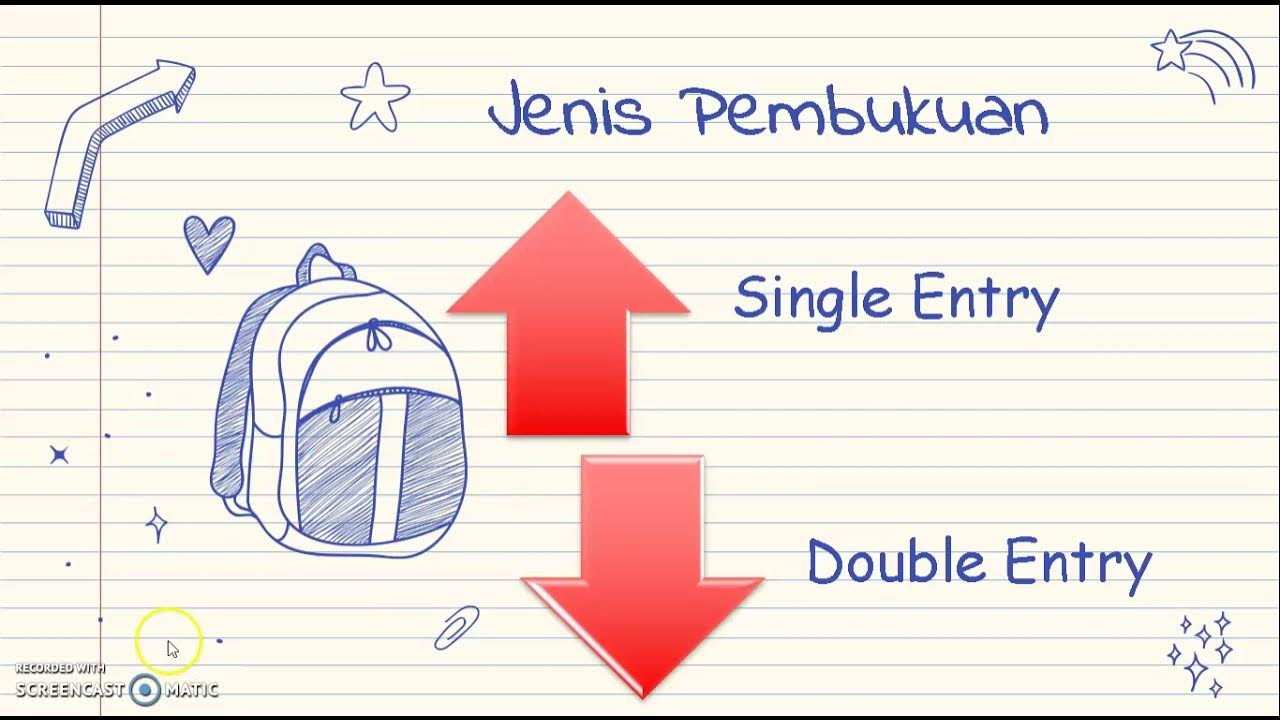Double Entry Accounting and t-accounts (Debits and Credits)
Summary
TLDRIn this 'Advantage' lecture, Matt Fisher introduces double-entry accounting, emphasizing its role in maintaining the accounting equation's balance. He explains the T-account, a visual tool for understanding debits and credits, and how they affect various accounts like assets, liabilities, equity, revenue, and expenses in both sole proprietorships and corporations. Fisher also reviews transactions, illustrating journal entries, and stresses the importance of understanding debits and credits for accurate financial recording.
Takeaways
- 📚 Double-entry accounting is a system where every transaction affects the accounting equation in two ways, ensuring debits always equal credits.
- 🔍 Understanding transactions is crucial before proceeding with double-entry accounting, as every transaction has at least two components.
- 📊 T-accounts are a visual representation used for analysis, with the left side for debits and the right side for credits, essential for learning debits and credits.
- 💡 Assets increase with debits and decrease with credits, with the accounting equation showing assets on the left and liabilities and equity on the right.
- 📈 Liabilities increase with credits and decrease with debits, reflecting their position on the right side of the accounting equation.
- 📉 Equity increases with credits and decreases with debits, as it is also on the right side of the accounting equation.
- 🏢 In a sole proprietorship or partnership, the capital account increases with credits, while withdrawals increase with debits, affecting equity.
- 📋 For corporations, common stock increases with credits, similar to the capital account in other business structures, representing ownership.
- 💼 Revenue accounts increase with credits, boosting equity, while expense accounts increase with debits, decreasing equity.
- 📝 Journal entries are the official way of recording transactions, with debits recorded before credits, and used for posting references in future videos.
- 🔑 Memorizing and understanding the effects of debits and credits on various accounts is essential for mastering double-entry accounting.
Q & A
What is the main topic of the lecture?
-The main topic of the lecture is double-entry accounting.
Why is it important to understand transactions before continuing with this lecture?
-It is important to understand transactions because every transaction affects the accounting equation in two ways, and this understanding is fundamental to grasping the principles of double-entry accounting.
What is the significance of debits and credits in accounting?
-Debits and credits are significant because they are used to record transactions in a self-balancing system where debits always equal credits.
What does a T-account represent and why is it used?
-A T-account is a visual representation used by accountants for analysis purposes, showing debits on the left side and credits on the right side, which helps in understanding the effects of transactions.
How do debits and credits affect assets in the accounting equation?
-Assets increase with debits and decrease with credits, as they are on the left side of the accounting equation.
What is the relationship between debits, credits, and liabilities in the accounting equation?
-Liabilities increase with credits and decrease with debits, as they are on the right side of the accounting equation.
How does equity behave in relation to debits and credits?
-Equity increases with credits and decreases with debits, as it is on the right side of the accounting equation.
What is the difference between equity accounts in a sole proprietorship and a corporation?
-In a sole proprietorship, the capital account increases with credits, while in a corporation, the common stock account increases with credits. The dividend account is unique to corporations and increases with debits.
What is the purpose of a journal entry in recording transactions?
-A journal entry is used to officially record transactions, showing debits first and then credits, which helps in maintaining the accounting equation balance.
Can you provide an example of a journal entry from the script?
-An example from the script is the journal entry for transaction one, where cash is debited by fifty thousand, and the owner's capital is credited by fifty thousand.
What is the importance of understanding debits and credits for the course?
-Understanding debits and credits is crucial as they are used throughout the course to prepare journal entries and affect all accounts, ensuring the accuracy of financial records.
Outlines

This section is available to paid users only. Please upgrade to access this part.
Upgrade NowMindmap

This section is available to paid users only. Please upgrade to access this part.
Upgrade NowKeywords

This section is available to paid users only. Please upgrade to access this part.
Upgrade NowHighlights

This section is available to paid users only. Please upgrade to access this part.
Upgrade NowTranscripts

This section is available to paid users only. Please upgrade to access this part.
Upgrade NowBrowse More Related Video

The ACCOUNTING EQUATION For BEGINNERS

Procedimentos Contábeis Básicos

TEORI AKUNTANSI #1 RINGKASAN SEJARAH DAN PERKEMBANGAN AKUNTANSI

Akuntansi Pemerintah SMK Kelas XI - Jenis Pembukuan Tunggal dan Berpasangan Akuntansi Daerah

How The BALANCE SHEET Works (Statement of Financial Position / SOFP)

ACCOUNTING BASICS: a Guide to (Almost) Everything
5.0 / 5 (0 votes)